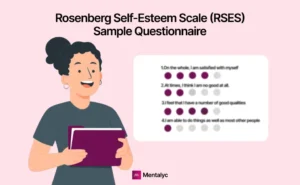The Strengths and Difficulties Questionnaire (SDQ) is a widely used behavioral screening tool that helps identify emotional and behavioral problems in children and adolescents. It was developed by British child psychiatrist Dr. Robert Goodman to provide a concise yet comprehensive overview of a young person’s mental health.
It captures both strengths and challenges across multiple domains, including emotional symptoms, conduct problems, hyperactivity, peer relationships, and prosocial behavior. Available for individuals aged 2 to 17, the SDQ can be completed by parents, teachers, or the children themselves, depending on age. This tool is especially valued for its targeted approach (just 25 core items), accessibility, and effectiveness in facilitating early detection of mental health issues.
Who is the Strengths and Difficulties Questionnaire for?
The SDQ is suitable for a broad range of clients, making it a versatile resource in both clinical and educational settings. Primarily, it targets children and adolescents aged 2 to 17 years. There are different versions of the questionnaire tailored for specific informants: the parent-report version, which is typically used for younger children, the teacher-report version, which is ideal for understanding a child’s functioning in school settings and the self-report version, which is generally suitable for youth aged 11 and up (Vugteveen et al., 2021). The tool is often employed by clinicians, psychologists, school counselors, pediatricians, and researchers to screen for mental health concerns, evaluate behavioral interventions, or collect data in academic studies and useful for psychoeducation.
Structure of the The Strengths and Difficulties Questionnaire
The SDQ consists of 25 items, grouped into five subscales, each with five items. These subscales include Emotional Symptoms, Conduct Problems, Hyperactivity/Inattention, Peer Relationship Problems, and Prosocial Behavior. Each question is answered using a three-point scale:
- “Not True”
- “Somewhat True”
- “Certainly True”
While the first four subscales focus on difficulties and contribute to the Total Difficulties Score, the Prosocial Behavior subscale is analyzed separately to reflect the individual’s strengths. In addition to the core items, an optional impact supplement asks about the extent to which any difficulties interfere with the child’s home life, friendships, classroom learning, and leisure activities. This added section can provide valuable context regarding the real-world implications of a child’s reported issues (Murray et al., 2022.)
SDQ Scoring and Interpretation
Scoring the SDQ involves summing the scores of each subscale, with each item contributing 0 to 2 points. The Total Difficulties Score is derived by adding the scores of the Emotional Symptoms, Conduct Problems, Hyperactivity/Inattention, and Peer Problems subscales, giving a total between 0 and 40. Each subscale score and the total score are then categorized into bands:
- Normal
- Borderline
- Abnormal
These thresholds help identify whether a child may need further evaluation. For example, in the parent-report version for children aged 4–17, a Total Difficulties Score of 0–13 is considered normal, 14–16 borderline, and 17–40 abnormal. While scoring can be done manually, many clinicians and educators use online tools to streamline the process and generate visual summaries for easier interpretation (Vugteveen et al., 2021).
When and How to Use the SDQ in Therapy
In therapeutic settings, the The Strengths and Difficulties Questionnaire serves as a valuable tool for initial assessment, treatment planning, and progress monitoring. It is typically administered during intake or early sessions to identify areas of concern and establish a baseline. Over the course of therapy, the SDQ can be re-administered to track changes in the child’s behavior and emotional state. Therapists can use the results to guide therapy sessions, validate the child or family’s experiences and tailor interventions to the individual’s specific needs.
It is especially useful for understanding how difficulties affect daily functioning, offering insights into whether additional support is required in school, home, or social environments. The SDQ’s structured format can also facilitate collaboration among caregivers, teachers, and mental health providers.
When working with children, the Strengths and Difficulties Questionnaire can help therapists better understand a child’s internal world, especially when the child may have limited ability to articulate their feelings. Administering the SDQ to both caregivers and, if age-appropriate, the child, can highlight discrepancies in perceptions that inform therapeutic goals. For example, a child might score high in peer problems on a self-report, while a parent may not perceive social difficulties—this contrast becomes a meaningful entry point for therapy. The SDQ can also provide a non-threatening way for children to participate in their own assessment process.
Although the SDQ was designed for youth, its structure can inspire the development of similarly styled assessments for adults, particularly those with neurodevelopmental conditions such as ADHD or autism, whose difficulties may mirror childhood behavioral profiles. In adult therapy, clinicians sometimes adapt the SDQ informally to help clients reflect on longstanding behavioral patterns and social functioning. The emphasis on both strengths and difficulties also encourages adults to recognize their capabilities alongside their challenges, fostering a more balanced self-view.
In couples therapy, the SDQ can offer a creative and indirect approach to understanding family dynamics—especially when the couple shares parenting responsibilities. When both partners complete the SDQ on behalf of their child, their differing perspectives can reveal misalignments in parenting approaches, communication patterns, and emotional attunement. These insights can guide discussions around co-parenting strategies and emotional regulation within the family unit, contributing to deeper relational work (Shenaar-Golan and Hen, 2024).
In school settings, the SDQ is frequently used by counselors, teachers, and school psychologists to identify students who may need additional support. It can be incorporated into school-wide mental health screenings or used individually when behavioral concerns are raised. The teacher version provides valuable insight into how the child interacts in academic and social environments, while comparisons with parent and student self-reports can help create tailored support plans (Martinsone et al., 2022). The SDQ can also help guide decisions about referrals to special education services or school-based interventions.
Benefits of the SDQ in Mental Health and Education
The SDQ is widely recognized for its practical benefits in both mental health and educational contexts. It is brief and easy to administer, typically taking only 5–10 minutes to complete. Its dual focus on strengths and difficulties encourages a balanced perspective, which can reduce stigma and promote constructive dialogue. Because the SDQ includes multiple versions, it offers a well-rounded view of the child’s functioning across different environments. This makes it especially useful for identifying discrepancies between home and school behaviors, thereby facilitating more comprehensive intervention strategies (Moulin et al., 2022).
In schools, the SDQ can inform decisions about referrals to school psychologists or special education services, while in clinical settings, it supports early identification and monitoring of mental health symptoms. Its proven validity and reliability across diverse populations add to its appeal as a trusted screening tool.
Limitations and Cultural Considerations
Despite its strengths, the SDQ is not without limitations. It is a screening tool, not a diagnostic instrument, and should be used in conjunction with other assessments and clinical judgment. Cultural sensitivity is another important consideration. Some behaviors assessed in the SDQ may be interpreted differently across cultures, potentially affecting the accuracy of the results. For instance, expressions of emotional distress or hyperactivity may vary in acceptability and visibility in different communities.
Moreover, the subjectivity of respondents—especially when comparing parent, teacher, and self-reports—can lead to discrepancies that require careful interpretation. While the SDQ has been translated into over 80 languages, ensuring cultural relevance and appropriate cut-offs for different populations remains a challenge.
Where to Access the SDQ (Free and Licensed Versions)
The SDQ is freely available for non-commercial use and can be accessed through its official website. The site provides downloadable versions for various age groups and informants, as well as translations in multiple languages. It also includes scoring instructions, interpretation guidelines, and access to the optional impact supplement. For organizations or developers wishing to integrate the SDQ into commercial platforms, such as electronic health record systems or mental health apps, a license must be obtained.
The website outlines licensing terms and provides contact information for requesting permissions. With its accessibility, versatility, and established track record, the SDQ continues to be a foundational tool for professionals working to support the emotional and behavioral well-being of children and adolescents.
Conclusion
The Strengths and Difficulties Questionnaire (SDQ) remains a powerful and accessible tool for identifying behavioral and emotional concerns in children and adolescents. Its strength lies in its balanced approach—capturing both the difficulties and the capabilities of individuals—making it invaluable in therapy, educational systems, research, and family dynamics. Whether used by mental health professionals, educators, or caregivers, the SDQ promotes early intervention, supports informed decision-making, and encourages collaborative care. While mindful of its limitations and the need for cultural context, the SDQ continues to be an essential component of comprehensive, strengths-based mental health practice.
Why other mental health professionals love Mentalyc

“I benefit tremendously every time I wrap up a session and then a few minutes later, I have this AI note … it makes me a better clinician in a variety of ways.”

“It helps align the note and the plan for moving forward with sessions … it’s been a really good aid in giving me direction.”
LPC

“It improves the quality of my work as I review my sessions … I bring a sense of continuity from session to session because of the really good summary and progress notes that Mentalyc gives me.”
Licensed Marriage and Family Therapist

“I go back and can read the notes, and it really helps me for the next session … it has made me a much better counselor.”
Licensed Professional Counselor







